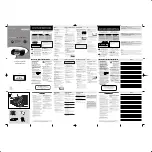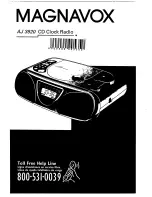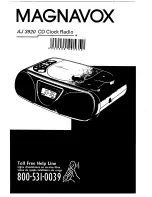
Instruction Manual
Page 11 of 25
PREPARATION
WARNING!
VARIOUS ELECTRONIC EQUIPMENT IN YOUR VEHICLE MAY
MALFUNCTION IF THEY ARE NOT PROPERLY PROTECTED FROM THE
RADIO FREQUENCY ENERGY WHICH IS PRESENT WHILE TRANSMITTING.
ELECTRONIC FUEL INJECTION, ANTI-SKID BRAKING, AND CRUSE
CONTROL SYSTEMS ARE TYPICAL EXAMPLES OF EQUIPMENT THAT MAY
MALFUNCTION. IF YOUR VEHICLE CONTAINS SUCH EQUIPMENT,
CONSULT THE DEALER FOR THE MAKE OF THE VEHICLE AND ENLIST HIS
AID IN DETERMINING IF THEY WILL PERFORM NORMALLY WHILE
TRANSMITTING.
Note: The following preparation instructions are for use by your ComSpaceCorporation
dealer, an authorized ComSpace Corporation service facility, or the factory.
TOOLS REQUIRED
Note:
Before installing the transceiver, always check how far the mounting screws will
extend below the mounting surface. When drilling mounting holes, be careful not to
damage wiring or parts.
The following tools are required for installation of the transceiver:
•
¼ inch (6 mm) or larger electric drill
•
drill bits (sizes listed below)
Description
Purpose
Drill size 9 (0.196”)
Pre-drill 0.196” holes for #12-24 self-threading screws
for use with Mounting Bracket
Drill size 9/64”
Pre-drill 0.141” holes for M4x6 self-threading screws
for use with Microphone Hanger
Phillips screwdriver or torx
driver
Drive the self-threading screws into the plastic or metal
Crimp Tool
Thomas & Betts No. WT-1300; Radio Shack No. 64-
409; General Electric – U.S. & Metric Terminal Tool
POWER CABLE CONNECTION
CAUTION:
THE TRANSCEIVER OPERATES IN 12 V NEGATIVE GROUND
SYSTEMS ONLY! CHECK THE BATTERY POLARITY AND VOLTAGE OF THE
VEHICLE BEFORE INSTALLING THE TRANSCEIVER.
1. Many vehicles provide a hole that is conveniently located in the firewall to allow for
the installation of equipment cables. Check for an existing hole that can be used to
pass the power cable from the engine compartment, through the firewall, to the
passenger compartment.











































